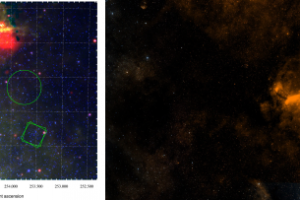Low mass stars in the OB association Scorpius OB1

OB associations are groups of massive stars (with spectral type O and B, more massive than 3.5 solar masses) which typically cover wide regions in the sky. The presence of such a rich population of massive stars suggests the presence of even a larger population of low-mass stars. There exists, in fact, a relation between the number of stars in different bins of mass which are produced by the star formation process, called Initial Mass Function. The universality of the Initial Mass Function has been proved so far both by observations and theoretical studies.
It is however quite difficult to identify the low mass population of OB associations. The most effective method to identify low mass young stars is by using X-ray observations. Young stars are in fact 1000/10000 times brighter in X-rays than evolved stars. However, the field of view of available X-ray observatories is much smaller than the typical extent of OB associations. Techniques available over wide regions (such as those based on photometric data in the infrared bands or in bands covering the Hα line) are sensitive only to those young stars still bearing a protoplanetary disk.
In the study “The low-mass pre-main sequence population of Scorpius OB1” of F. Damiani (INAF – Astronomical Observatory of Palermo), recently published on Astronomy & Astrophysics, these techniques are deployed together with a new technique developed by the author of this study and which is effective in selecting young M type stars (which constitute more than 70% of the expected stellar population), with the aim of selecting the low mass stellar population of the OB association Scorpius OB1. This association is about 5° wide, and it contains together with a diffuse stellar population, so far unidentified, the young (2-8 million years) compact cluster NGC 6231 and the sparse cluster less than 10 million years old Trumpler 24. Thanks to the combined use of different detection techniques, the author of this study identified more than 4000 low mass members of Scorpious OB1, being able to analyze the chronology of star formation in the association, the connection and properties of NGC 6231 and Trumpler 24, and to estimate the total mass of the association equal to about 4500 solar masses.
The figure (link) shows an infrared image from WISE satellite of Scorpius OB1.
